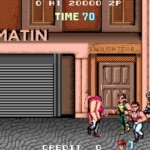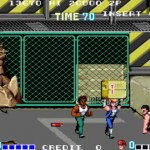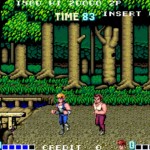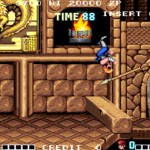DOUBLE DRAGON
By Sean HarrisThe team-with-a-friend beat ’em up that started them all. Ok, so technically Irem’s VIGILANTE began the side scrolling punch and kick craze (itself derived from their own KUNG-FU MASTER before it) and Taito, American distributor of this here classic, already had RENEGADE under their belt, which had a great deal of the game engine already mapped out, but STILL. DOUBLE DRAGON, man. The first one that caught on with the idea that you could pair up with a friend, simultaneously, and mash buttons together in back-to-back glory. The first one, essentially, that laid the groundwork for all the cooperative clones to follow.
Player one is Spike (or Billy Lee, as he’s known in the Japanese version and subsequent home releases) and player two is Hammer (conversely, Jimmy Lee). Their girlfriend, Marion, has been kidnapped by the Shadow Warrior gang, a posse of street thugs that have taken over the city. Your goal is simple: traverse four stages, kicking the can of all the enemies in your path, and free Marion from their machine gun wielding boss.
Using a standard set of punch, kick, and jump buttons (and several combinations thereof), either player can deal out right crosses, high kicks, jump kicks, spin kicks, uppercuts, elbow attacks, and even a deliciously devastating attack that involves grabbing an opponent by their hair, kneeing them in the face, and flipping them over your shoulder. There’s also a nifty head-butt maneuver, which can be dealt by simply pushing the joystick twice in the desired direction you wish to crack your melon. Enemy characters have varying similar attacks, mostly in the kick/punch/jump kick range (although one can also pull the face-to-knee, elbow attack, and spin kick right back on you), but they can also grab you from behind, pinning you while another enemy throws a few jabs into your gut. Hit your buttons repeatedly to get out of this dirty hold, and take solace in the fact that you too can perform this trick in return if you are playing with a friend in tow.
Unique to this collection of moves is the ability to pick up weapons dropped by your opponents. Women will drop whips, men will discard baseball bats and knives, and there are even some fun extras like dynamite sticks, cargo crates, and boulders to snatch up and foist upon your nearby assailants.
The levels comprising DOUBLE DRAGON are as follows: stage one is the city slums, stage two the industrial area, stage three the woodland outskirts, and stage four the hideout of the Shadow Warrior gang. It isn’t a terribly long trek, and in this case it’s a good thing, because the mindless repetition of the game itself tends to wear out its welcome. Seasoned players can breeze through in fifteen minutes or so, which is just about enough time to ease the itch. The game difficulty sits firmly in the medium category, or at least until you’ve mastered the elbow attack, where you’re biggest adversary will then be reduced to missing a critical jump over a ledge, falling off level 2’s conveyor belt, or taking a chest full of lead from the armed bastard at the end showdown.
Graphically, DOUBLE DRAGON holds up pretty well, even twenty six years later. There’s no particularly complex, parallax scrolling background plates, or super huge sprites sporting every shaded muscle and vein (Abobo, the ripped giant, is fairly large, however), but there is a charm to the just-detailed-enough cast of characters and colorful environments. The stage designs are quite fun, with ladders to climb on, pits and bridges to toss enemies from, and even some amusing and slightly annoying traps to traverse on the final level. The sound effects are where it excelled at the time of release, however. The meaty, movie sampled ‘thwoks’ and ‘cracks’ of flesh hitting flesh and bone were the best heard out of arcade speakers circa 1987, and it helps sell home the experience of a good old fashioned street brawl. The music is also pretty flashy, with driving, blood pumping themes to punctuate your vengeful assault upon the bad guy’s turf (though I think they were actually improved by the inferior sound chip of the NES, by some bizarre twist of the absurd).
Player control is solid enough for the most part, and you won’t have any trouble picking up the nuances of the many attack methods. Unfortunately, the one thing holding it back is a strange one for an arcade release–it has a curious amount of slowdown whenever more than three characters appear on screen. Since it seems to allow anywhere up to about five sprites together at once, it becomes quite a problem in places. A little more oomph in the megahertz department would have helped the overall fluidity of the game’s execution.
Despite this, DOUBLE DRAGON earns its popular status. It was just enough of a new thing at the time, and it’s just enough of good thing today. Where many in its footsteps went on endlessly and became boring fairly quickly, this old dog knew how to give it to you in just the right manner and dose.



